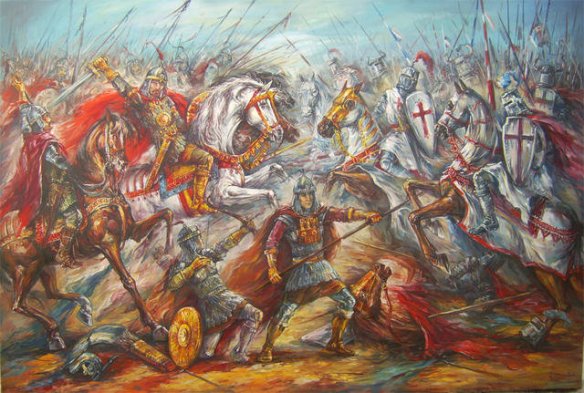The Battle of Adrianople occurred on April 14, 1205 between Bulgarians and Cumans under Tsar Kaloyan of Bulgaria, and Crusaders under Baldwin I, who only months before had been crowned Emperor of Constantinople. It was won by the Bulgarians, who took Baldwin prisoner.
AN IMPERIAL CORONATION
On 16th May 1204 Baldwin of Flanders was crowned the first emperor of the Latin empire of Constantinople. The ceremony in Hagia Sophia, the great church built by the emperor Justinian in the sixth century, was a mixture of both western and eastern practices that combined the magnificent pomp and splendor of a traditional Byzantine coronation with Latin rites. Robert of Clari, who was in attendance, described the spectacle:
“When the emperor was come before the altar, he knelt down… then all the bishops went and took hold of the crown all together and blessed it and made the sign of the cross on it and put it on his head. And then to serve as a clasp they hung about his neck a very rich jewel which the emperor Manuel had once bought for 62,000 marks. When they had crowned him, they seated him on a high throne, and he was there while the mass was sung, and he held in one hand his scepter and in the other hand a golden globe with a cross on it. And the jewels which he was wearing were worth more than the treasure of a rich king would make. When the mass was heard, they brought him a white horse on which he mounted. Then the barons took him back to his palace of Boukoleon and seated him on the throne of [the Roman emperor] Constantine [the Great].”
After the death of Saladin in 1193, Pope Innocent III launched the Fourth Crusade. Judging the moment auspicious, Innocent encouraged the nobility of Europe to don the crusader’s mantle. The Venetians agreed to ship the crusading army to the east but subverted it from its goal by using it first to capture Zara, a Christian port on the Dalmatian coast. The crusading army thus became enmeshed in Byzantine politics.
At the start of the thirteenth century, the Byzantine Empire was experiencing yet another struggle for the imperial throne. One contender, Alexius, son of the overthrown Emperor Isaac II, appealed to the crusaders in Zara for assistance, offering them 200,000 marks in silver (the Venetians were getting 85,000 as a transport fee) and reconciliation of the Eastern Orthodox Church with the Roman Catholic Church. The Crusade leaders now diverted their forces to Constantinople. When the crusading army arrived, the deposed Isaac II was reestablished with his son, Alexius IV, as co-emperor. Unfortunately, the emperors were unable to pay the promised sum. Relations between the crusaders and the Byzantines deteriorated, leading to an attack on Constantinople by the crusaders in the spring of 1204. On April 12, they stormed and sacked the city. Christian crusaders took gold, silver, jewelry, and precious furs, while the Catholic clergy accompanying the crusaders stole as many relics as they could find.
The Byzantine Empire now disintegrated into a series of petty states ruled by crusading barons and Byzantine princes. The chief state was the new Latin Empire of Constantinople led by Count Baldwin of Flanders as emperor. The Venetians seized the island of Crete and secured domination of Constantinople’s trade. Why had the western crusaders succeeded so easily when Persians, Bulgars, and Arabs had failed for centuries to conquer Constantinople? Although the crusaders were no doubt motivated by greed and a lust for conquest, they were also convinced that they were acting in God’s cause. After all, a Catholic patriarch (a Venetian) had now been installed in Constantinople, and the reconciliation of Eastern Orthodoxy with Catholic Christianity had been accomplished. Nor should we overlook the military superiority of the French warriors and the superb organizational skills of the Venetians; together, they formed a union of great effectiveness and power.
Revival of the Byzantine Empire
Although he protested the diversion of the crusade from the Holy Land, Pope Innocent III belatedly accepted as ‘‘God’s work’’ the conversion of Greek Byzantium to Latin Christianity. Some have argued that Innocent did realize, however, that the use of force to reunite the churches virtually guaranteed the failure of any permanent reunion. All too soon, this proved correct. The west was unable to maintain the Latin Empire, for the western rulers of the newly created principalities were soon engrossed in fighting each other. Some parts of the Byzantine Empire had managed to survive under Byzantine princes. In 1259, Michael Paleologus, a Greek military leader, took control of the kingdom of Nicaea in western Asia Minor, led a Byzantine army to recapture Constantinople two years later, and then established a new Byzantine dynasty, the Paleologi.
The Byzantine Empire had been saved, but it was no longer a Mediterranean power. The restored empire was a badly truncated entity, consisting of the city of Constantinople and its surrounding territory, some lands in Asia Minor, and part of Thessalonica. It was surrounded by enemies—Bulgarians, Mongols, Turks, and westerners, especially the resentful Venetians. And there was still internal opposition to Michael VIII. But the emperor survived and began a badly needed restoration of Constantinople.
Even in its reduced size, the empire limped along for another 190 years, and Constantinople remained an active economic center. Scholars continued to study the classics, and new churches and monasteries were built. Civil strife continued as rival claimants struggled over the throne. And enemies continued to multiply; the threat from the Turks finally doomed the aged empire.
